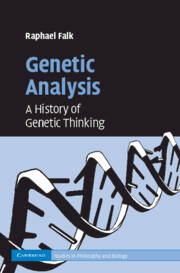Book contents
- Frontmatter
- Contents
- List of figures
- Acknowledgments
- Introduction
- PART I FROM REPRODUCTION AND GENERATION TO HEREDITY
- PART II FAKTOREN IN SEARCH OF MEANING
- PART III THE CHROMOSOME THEORY OF INHERITANCE
- PART IV GENES AS THE ATOMS OF HEREDITY
- PART V INCREASING RESOLVING POWER
- PART VI DEDUCING GENES FROM TRAITS, INDUCING TRAITS FROM GENES
- 14 How do genes do it?
- 15 The path from DNA to protein
- 16 Genes in the service of development
- PART VII WHAT IS TRUE FOR E. COLI IS NOT TRUE FOR THE ELEPHANT
- Concluding comments
- Bibliography
- Index
16 - Genes in the service of development
Published online by Cambridge University Press: 07 August 2009
- Frontmatter
- Contents
- List of figures
- Acknowledgments
- Introduction
- PART I FROM REPRODUCTION AND GENERATION TO HEREDITY
- PART II FAKTOREN IN SEARCH OF MEANING
- PART III THE CHROMOSOME THEORY OF INHERITANCE
- PART IV GENES AS THE ATOMS OF HEREDITY
- PART V INCREASING RESOLVING POWER
- PART VI DEDUCING GENES FROM TRAITS, INDUCING TRAITS FROM GENES
- 14 How do genes do it?
- 15 The path from DNA to protein
- 16 Genes in the service of development
- PART VII WHAT IS TRUE FOR E. COLI IS NOT TRUE FOR THE ELEPHANT
- Concluding comments
- Bibliography
- Index
Summary
Concerning the matter of functioning of genes during development, I have contrasted … two possible views, and suggested a third. … It is known that the protoplasm of different parts of the egg is somewhat different, and that the differences become more conspicuous as the cleavage proceeds … From the protoplasm are derived the materials for the growth of the chromatin and for the substances manufactured by the genes. The initial differences in the protoplasmic regions may be supposed to affect the activity of the genes. The genes will then in turn affect the protoplasm, which will start a new series of reciprocal reactions. In this way we can picture to ourselves the gradual elaboration of differentiation of various regions of the embryo.
Morgan (1934a, 9–10)In his classical paper of 1913 on the linear arrangement of sex-linked factors in Drosophila, Sturtevant described the phenotypes of the wings in combinations of genotypes: “The normal wing is RM. The rM wing is known as miniature, the Rm as rudimentary, and the rm as rudimentary-miniature” (Sturtevant, 1913b). The miniature phenotype is produced by a mutation in the rudimentary gene and vice versa, the rudimentary phenotype is produced by a mutation in the miniature gene.
This terminology, unlike the terminology we use today, had been introduced by Morgan: it reflected his sensitivity to the epistemological significance of the notation describing experimental results.
- Type
- Chapter
- Information
- Genetic AnalysisA History of Genetic Thinking, pp. 231 - 244Publisher: Cambridge University PressPrint publication year: 2009



